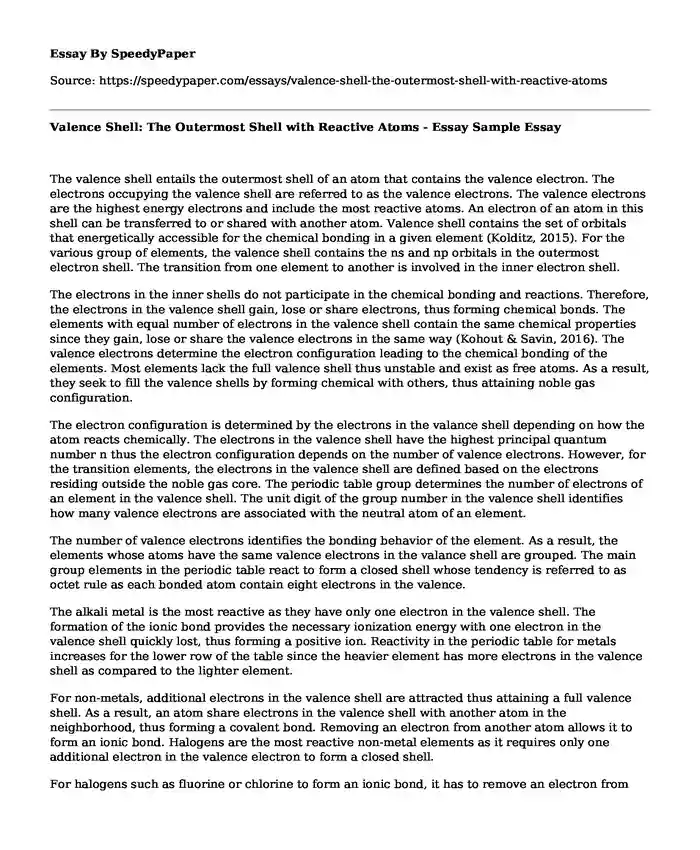The valence shell entails the outermost shell of an atom that contains the valence electron. The electrons occupying the valence shell are referred to as the valence electrons. The valence electrons are the highest energy electrons and include the most reactive atoms. An electron of an atom in this shell can be transferred to or shared with another atom. Valence shell contains the set of orbitals that energetically accessible for the chemical bonding in a given element (Kolditz, 2015). For the various group of elements, the valence shell contains the ns and np orbitals in the outermost electron shell. The transition from one element to another is involved in the inner electron shell.
The electrons in the inner shells do not participate in the chemical bonding and reactions. Therefore, the electrons in the valence shell gain, lose or share electrons, thus forming chemical bonds. The elements with equal number of electrons in the valence shell contain the same chemical properties since they gain, lose or share the valence electrons in the same way (Kohout & Savin, 2016). The valence electrons determine the electron configuration leading to the chemical bonding of the elements. Most elements lack the full valence shell thus unstable and exist as free atoms. As a result, they seek to fill the valence shells by forming chemical with others, thus attaining noble gas configuration.
The electron configuration is determined by the electrons in the valance shell depending on how the atom reacts chemically. The electrons in the valence shell have the highest principal quantum number n thus the electron configuration depends on the number of valence electrons. However, for the transition elements, the electrons in the valence shell are defined based on the electrons residing outside the noble gas core. The periodic table group determines the number of electrons of an element in the valence shell. The unit digit of the group number in the valence shell identifies how many valence electrons are associated with the neutral atom of an element.
The number of valence electrons identifies the bonding behavior of the element. As a result, the elements whose atoms have the same valence electrons in the valance shell are grouped. The main group elements in the periodic table react to form a closed shell whose tendency is referred to as octet rule as each bonded atom contain eight electrons in the valence.
The alkali metal is the most reactive as they have only one electron in the valence shell. The formation of the ionic bond provides the necessary ionization energy with one electron in the valence shell quickly lost, thus forming a positive ion. Reactivity in the periodic table for metals increases for the lower row of the table since the heavier element has more electrons in the valence shell as compared to the lighter element.
For non-metals, additional electrons in the valence shell are attracted thus attaining a full valence shell. As a result, an atom share electrons in the valence shell with another atom in the neighborhood, thus forming a covalent bond. Removing an electron from another atom allows it to form an ionic bond. Halogens are the most reactive non-metal elements as it requires only one additional electron in the valence electron to form a closed shell.
For halogens such as fluorine or chlorine to form an ionic bond, it has to remove an electron from another atom thus forms an anion. Forming a covalent bond requires the halogens to get one electron from another atom to have a shared pair. For non-metals, reactivity decreases down the group since the electrons in the valence shell are at progressively higher energies thus less tightly bound.
References
Kohout, M., & Savin, A. (2016). Atomic shell structure and electron numbers. International
Journal of Quantum Chemistry, 60(4), 875–882. https://doi.org/10.1002/(SICI)1097-461X(1996)60:4<875::AID-QUA10>3.0.CO;2-4
Kolditz, L. (2015). Transition Metal Chemistry — The Valence Shell in d-Block Chemistry.
Zeitschrift Für Physikalische Chemie, 190(Part_2), 309–310. https://doi.org/10.1524/zpch.1995.190.Part_2.309a
Cite this page
Valence Shell: The Outermost Shell with Reactive Atoms - Essay Sample. (2023, Nov 14). Retrieved from https://speedypaper.com/essays/valence-shell-the-outermost-shell-with-reactive-atoms
Request Removal
If you are the original author of this essay and no longer wish to have it published on the SpeedyPaper website, please click below to request its removal:
- Free Essay on Existence and Uniqueness of Control Theory
- Free Essay Describing Galaxies
- Cellular Graphene: Fabrication and Mechanical Properties. Essay Sample
- Paper Example. The Health Conditions of the Married and Unmarried People
- Essay Sample on Criminal Law: Exclusionary Rules
- UK Trade Consultancy: Essential in Post-Brexit World - Essay Sample
- Essay on Bacterial Virulence Mechanisms: Unveiling the Role of Fimbriae, Flagella, Capsules, and Cell Membranes
Popular categories





